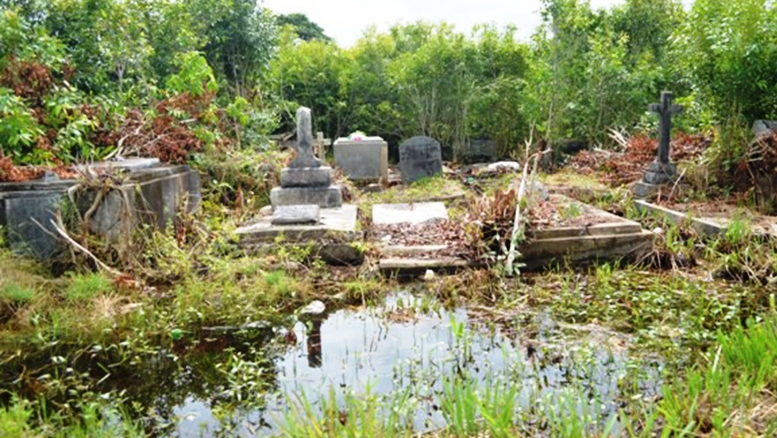The chain link fences stretched from Sussex Street to Princess Street, running parallel to the length of Cemetery Road – a major travel artery with two lanes of traffic running against each other; cars competing with donkey carts and the more upscale horse carts, small engine motor cycles wending between cars and carts closely followed by bicycles, while pedestrians stepped as close to the chain link as they could to avoid being casualties of erratic traffic patterns.
Middle Road Burial Ground ran perpendicular to Cemetery Road and further west, Louisa Rowe ran across Princess Street, cutting around that giant Statue of Angel Gabriel, steering traffic out to Sussex Street. Somewhere east of the Louisa Rowe and Sussex Street area was the Post Mortem building where science students from high school were allowed to witnessed the post mortem process.
Back then, too, tombs were laid out in linear fashion interrupted only by the occasional mausoleum; the most famous being that of the Abrahams – the family that lost nine relatives, seven of which were children, in a tragic fire at their residence, 99 Hadfield Street, on June 12th 1964, because of some alleged unauthorized sharing of information by patriarch, Arthur Abraham, who was then Cheddi Jagan’s Permanent Secretary.
This is what Le Repentir looked like back when there was still some pride in the practice of politics; when common human decency took its place above culture and respect for the deceased was marked by a collective reverence to burial sites.
This was the one burial ground that represented Guyana’s cross cultural fabric even in death, with its distinct sections for Chinese and Catholics and Muslims and Hindus and Presbyterians and Bahai’s and Anglicans and paupers and prisoners.
And this cemetery is historic, even in its establishment – a former sugar plantation turned burial ground by a French Huguenot (Protestant) who had killed his brother in a duel over land and named this place of eternal rest for the grief he felt. The richness of the heritage includes, too, the interment of the first person ever buried there – a Portuguese immigrant, Antonio Gonzales, on March 15 1861. It is, also, the final resting place of the Enmore Martyrs – five sugar workers who were shot to death while demonstrating against deplorable working conditions imposed by colonial rulers.
So, when Le Repentir, this stretch of land designated for final rest, with all of its historical references, rich cultural recall and sacrosanctity became overrun with bushes, hives of African bees, snakes, was designated a dump for trash, dead animals and the above ground disposal of dead bodies that were not retrieved from funeral parlors within the allotted time, the conclusion was that the government of the day, the Administration headed by the People’s Progressive Party, was bereft of ethnographic nationalism, and ignorant of the importance of preserving objects landscapes and other artifacts of historical significance.
What remains deeply offensive, hanging like a wart from an appendage, is the concerted mockery those who used to govern made of the concept of final resting place. Even as they commissioned more tons of trash to be moved to Le Repentir for disposal, as toxic flames burned daily, leaping miles into the air as far south as Riumveldt Industrial Park, wafting stench and disease up the nostrils of residents who had no choice but to inhale this assault on their environment, government pretended to “bemoan the deplorable state” of the cemetery, with a fiendish disregard that underscored their unfitness to govern.
As if it were a game, the ball of blame was kicked to Hamilton Green, the neutered Mayor whose two- decade tenure stood at the intersection of Politics and Power – a grid reference known as the perfect point for strangling constituents. There seemed to be unspoken concessions that the dead wouldn’t know they were receiving poor services, that families needed to blame the ineffective city council for the reported “double decking” of coffins because a lack of records made it a challenge to determine the location of previous graves and as bereaved families and concerned citizens demanded better service for the burial site, the government continued to thumb its nose at them by emblazoning the political sky line with headlines touting ‘Clean Up My Country’ campaigns, asserting that hundreds of millions had been “allocated” to the restoration of Le Repentir.
And, while the hundreds of millions were purportedly spent on repair, many in funeral processions would stand outside of the cemetery, afraid of having to navigate through foliage over hang, rodents and serpents in the grass that surrounded the grave. Boasting the repair of the cemetery was just another baseless bluff pulled by the PPP administration which did little to assuage the horror felt about the condoned desecration of this final resting place.
The new Administration has begun the process of restoring the purpose of Le Repentir and salvaging, for preservation, the history of those buried there.
Hopefully, this is the beginning of reinstating the tender regard afforded the dead in civilized societies and the final interment of the lack of civility shown by the last Administration, in venerating our deceased.
http://www.kaieteurnewsonline.com/2013/04/18/bodies-dumped-at-le-repentir-cemetery/
http://guyanachronicle.com/rohee-bemoans-deplorable-state-of-le-repentir-cemetery/
http://guyanachronicle.com/le-repentir-cemetery-being-restored/
http://www.kaieteurnewsonline.com/2009/07/23/over-300-tombs-desecrated-in-le-repentir/



[…] 23 years of the “Demons of the PPP”, for them to still hold strong appeal to voters who voted for the coalition but now feel that they […]